Number of Families With Children Under 18, Us
How many children live in Commonwealth of australia?
As at 30 June 2018, an estimated four.7 million children aged 0–14 lived in Commonwealth of australia. Boys fabricated up a slightly higher proportion of the population than girls (51% compared with 49%) (ABS 2018a).
The number of children in Australia has increased over the past 5 decades and is projected to increase to 6.4 one thousand thousand by 2048 (ABS 2018e). Still, due to sustained low fertility rates and increasing life expectancy, the number of children equally a proportion of the entire population steadily fell from 29% in 1968 to xix% in 2018. It is projected to autumn to 18% by 2048 (Figure 1) (ABS 2014; ABS 2018e).
Figure ane: Number of children and children as a proportion of the total Australian population, 1968–2048
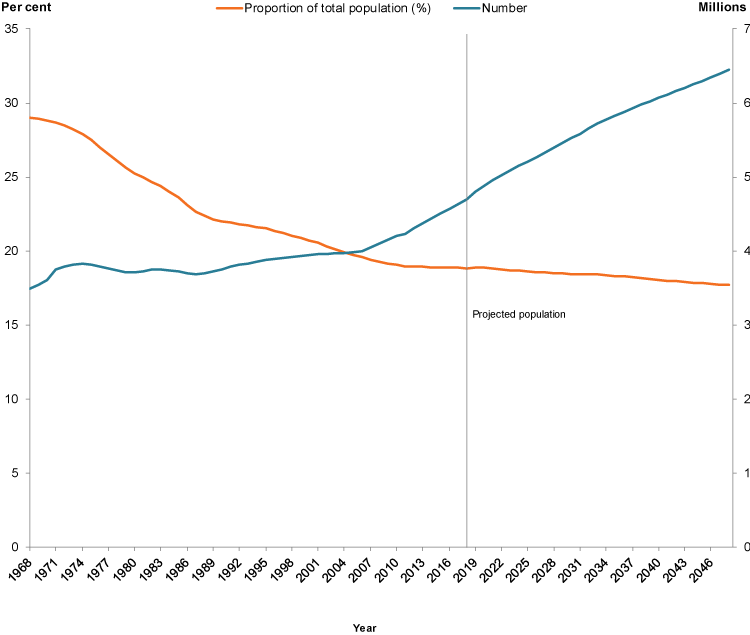
Note: Population projections (2019 onwards) are based on ABS Projection Series B. Come across ABS 2018e for the assumptions on which Project Series B is based.
Sources: ABS 2014; ABS 2018a; ABS 2018e.
Ancient and Torres Strait Islander children
In 2018, Aboriginal and Torres Strait Islander children made upwards 5.9% (an estimated 278,000) of the total child population in Australia. The gender distribution of Indigenous children was the same as for all Australian children (51% boys and 49% girls) (ABS 2018c).
Although Indigenous children incorporate a relatively pocket-size proportion of the Australian kid population, they correspond more than 1-third of the Ethnic population (34%) (ABS 2018c) (Figure 2).
The Indigenous population has a much younger age construction than the non-Indigenous population (Effigy 2). This reflects the higher fertility rate among Ethnic women compared with non-Indigenous women in Australia (2.3 births compared with 1.viii in 2017), besides as the shorter life expectancy amidst Indigenous Australians (ABS 2018b).
Figure 2: Age and sexual practice distribution of Indigenous and non-Indigenous populations, 2018
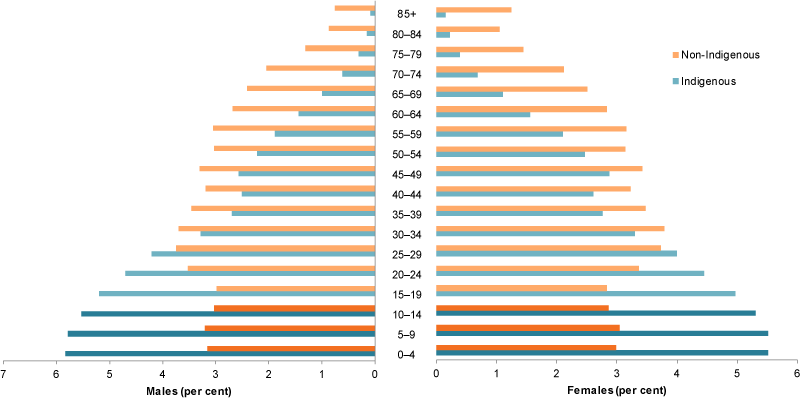
Source: ABS 2018c.
Overseas-born children
In Australia, just nether i in 11 (8.9% or around 411,000) children anile 0–14 were born overseas. This is considerably lower than the total overseas-born Australian population, with nearly one-third (29%) of the population in June 2017 born overseas (ABS 2018e).
About ane-third (34%) of overseas-built-in children were from other mainly English-speaking countries, with the largest populations from:
- Uk (13%)
- New Zealand (12%)
- U.s.a. of America (4%) (Figure 3).
Of the remaining ii-thirds (66%) born in mainly non-English language-speaking countries, the largest groups were from:
- India (11%)
- Communist china (6%)
- the Philippines (5%).
More than 1-fifth of children (23% or around 995,700) aged 0-14 had both parents born overseas, while another sixteen% (around 701,500) had ane parent born overseas (8.half-dozen% or around 373,200 with overseas-born fathers and seven.five% or around 328,300 with overseas-born mothers) (ABS 2016b).
Figure three: Leading countries of birth for children aged 0–xiv born overseas, June 2017
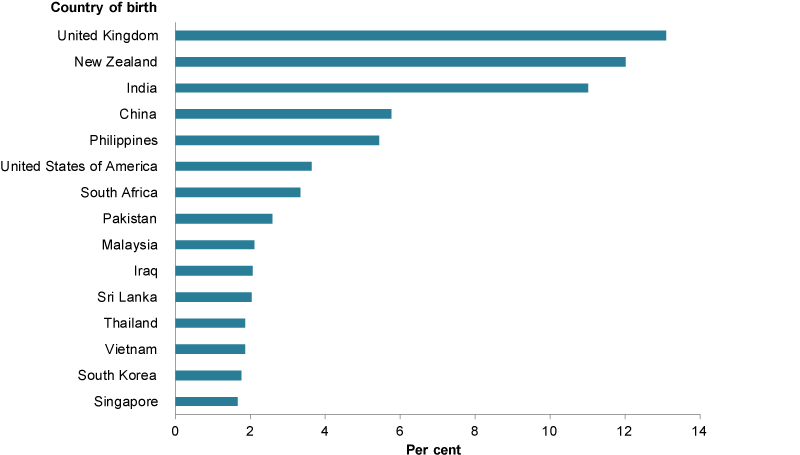
Notation: Information for Prc exclude Special Authoritative Regions and Taiwan Province.
Source: ABS 2018d.
Refugee children
In 2017–xviii, effectually 4,100 children aged 0–14 arrived in Australia under the Humanitarian Program for refugees and others in refugee-similar situations. Most of these children were:
- Syrian (15%)
- Iraqi (14%)
- Hazara (Afghan) (13%)
- Congolese (eight%).
These four ethnic groups made up almost half (49%) of all refugee children arriving in 2017–18 (Effigy 4).
The number of children aged 0–xiv arriving in Commonwealth of australia under the Humanitarian Program in 2017–18 was slightly lower than the number in 2008–09 (around iv,600). Numbers varied moderately betwixt 2008–19 and 2015–16, ranging from effectually 3,700 to 5,000, earlier peaking at around vii,900 children in 2016–17 (DSS 2019).
Figure 4: Leading ethnicities for refugee children aged 0–xiv arriving in Australia, 2017–18
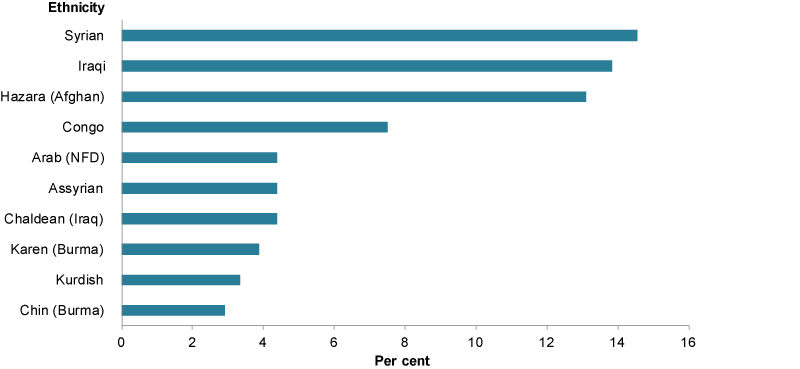
Abbreviations: NFD (Non further defined)
Source: AIHW analysis of DSS customised written report.
Children with inability
In 2015, around 7.iv% of children aged 0–14 had some level of disability.
For information on these children, run into disability.
Children in non-parental intendance
While the vast majority of children in Australia live with one or both of their biological parents, some parents are unable to care adequately for their children and these children are placed in non-parental intendance.
For information on these children, encounter non-parental intendance.
Where exercise children live?
States and territories
The population distribution of children beyond united states of america and territories is similar to that for all Australians. In 2018, nearly:
- one-third (32%) of Australian children lived in New Due south Wales
- one-quarter (25%) in Victoria
- one-fifth (21%) in Queensland (Figure 5) (ABS 2018a).
In 2018, the largest proportion of children in a state or territory was in the Northern Territory, where children made up more than than one-5th of the population (22%). In other states and territories, children made up between 18% (South Commonwealth of australia and Tasmania) and 20% (Queensland) of the respective population (ABS 2018a).
The higher proportion of children in the Northern Territory is largely due to the high number of Indigenous Australians, and the younger historic period structure of this population group. In 2016, Indigenous children made upward 9% of the Territory's full population, and 41% of the territory's population of children aged 0–14. In most other states, Indigenous children made up between ii% (Victoria) and 10% (Tasmania) of the child population (Figure 5) (ABS 2018c).
Effigy v: Distribution of Indigenous children aged 0-14 beyond the states and territories and remoteness areas, June 2016
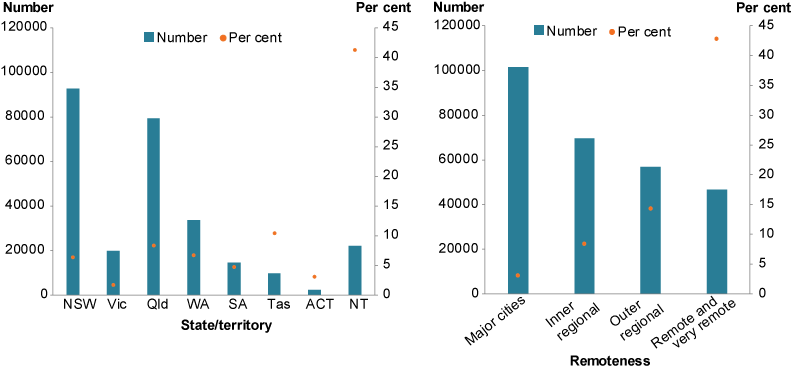
Notation: Number refers to the number of Indigenous children anile 0-fourteen within each state, territory or remoteness area. Per cent refers to the proportion of all children anile 0–14 within each land, territory or remoteness area.
Source: AIHW assay of ABS 2018c.
The population distribution of refugee children was similar to that of Australian children overall. Of refugee children arriving in 2017–18:
- 31% were living in New South Wales
- 31% in Victoria
- 19% in Queensland
- 8% in Southward Commonwealth of australia
- 6% in Western Commonwealth of australia (DSS unpublished information).
Remoteness
In 2016, more than 2-thirds (70% or 3.2 million) of Australian children aged 0–14 lived in Major cities, while:
- about one-fifth (18% or 841,700) lived in Inner regional areas
- 9% (404,000) lived in Outer regional areas
- ii% (109,400) lived in Remote and very remote areas (ABS 2017).
The majority of Indigenous children lived in Major cities, Inner regional and Outer regional areas in 2016 (83%, or around 227,800 children). Indigenous children:
- were more 7 times as likely to live in Remote and very remote areas (17%) every bit all Australian children (2.4%)
- deemed for 43% of all children in Remote and very remote areas, despite accounting for 6% of all children in Australia in 2016 (ABS 2018c).
Socioeconomic condition
In 2017, similar numbers of children aged 0–14 lived in high, medium and low socioeconomic areas:
- 21% (or around 953,700) children lived in the lowest socioeconomic areas
- 20% (effectually 921,900) lived in the highest socioeconomic areas.
How many Australian families accept children aged 0-14?
This department presents data according to a national definition of a family (Box 1) used for official statistical purposes. This definition may not always marshal with how a kid defines their family, and information technology may not align with the concept of a family for Indigenous Australians (AIHW & AIFS 2016).
From 2006 to 2016, the types of families that children were living in have changed very little. In 2006 and 2011, 81% of children aged 0–14 years lived in couple families; this rose to 82% in 2016 (ABS 2006; ABS 2011; ABS 2016a). In 2016, the rest (around 18%) lived in one-parent families (xviii%). Of these children, the majority (86%) lived with their mother (ABS 2016b).
The bulk of children living in couple families in 2016 lived with their natural or adopted parents (90%):
- 6% lived in blended families—a family with at least 1 child of both partners (natural or adopted) and at to the lowest degree 1 step child
- 3% lived in footstep families—a family with at least one step child and no natural or adopted children.
Children living in1-parent families, blended or step families may live according to shared-care arrangements agreed between their original parents; however no nationally consistent data are available on these arrangements. Less than 1% of children in couple families lived in other arrangements, such as grandparent families and families with foster children only.
For more than information on children living in grandparent families, run across Children in non-parental care.
A higher proportion of infants and young children (anile 0–4) lived in couple families in 2016 (86%), compared with 81% of those anile 5–9 and 78% of those aged 10–xiv. Conversely, in ane-parent families a considerably higher proportion of children were anile ten–xiv than 0–4 (22% compared with fourteen%) (ABS 2016b).
A minor number of children live in adoptive families. In 2017–eighteen, in that location were 263 adoptions of children aged 0–14 in Australia (this includes known, local and intercountry adoptions) (AIHW 2018).
Box 1: Definition of family
The ABS defines a family as two or more persons, i of whom is at least fifteen years of age, who are related by blood, marriage (registered or de facto), adoption, step or fostering, and who usually alive in the same household (ABS 2016c).
Recognising the changing nature and understanding of family formation—including who makes upwards a family unit and the relationships existing within that family unit—the ABS is exploring definitions of family beyond its full suite of surveys and information sources.
Source: https://www.aihw.gov.au/reports/children-youth/australias-children/contents/background/australian-children-and-their-families
0 Response to "Number of Families With Children Under 18, Us"
Post a Comment